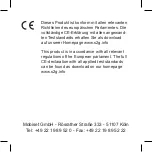
Commissioning
24
Operating instructions for the natural gas-fuelled CHP module
VITOBLOC 200
6130329
GB
3
Commissioning
3.1
Authorized personnel
NOTE
The commissioning which is to be car-
ried out by the factory service centre
must be applied for with the relevant
notification well in time, i.e. at least 4
weeks before the desired date.
CAUTION
Only a specialist firm with personnel
suitably trained for this assignment by
the CHP module manufacturer is au-
thorized to carry out the initial start-up
of the CHP module. The accident pre-
vention regulations must be observed.
LIABILITY.
The initial start-up of the CHP module
shall be carried out in consultation with
the plant manufacturer and the plant
operator and in the presence of their
authorized representatives.
●
Only suitably qualified personnel are authorized to
check the installation and to carry out the commis-
sioning.
●
Never let the engine start dry. i.e. without being
filled with lubrication oil or coolant.
●
When starting the engine, do not use any addition-
al starting aid (such as a start pilot).
●
Do not switch off the engine, when running under
full load, let it idle for approx. 5 min, so as to facili-
tate the temperature compensation especially at
the exhaust gas turbocharger.
●
Never fill cold coolant into an overheated engine.
●
Do not fill in engine oil above the maximum notch
at the dipstick. This can severely damage the en-
gine.
●
Make sure that the control and monitoring equip-
ment (alternator charging light, oil pressure, cool-
ant temperature) function properly.
●
The gaseous fuel has to meet the minimum re-
quirements as per Table 3. Only use fuels that
meet specifications, otherwise the manufacturer’s
liability for defects is forfeited.
●
Before start-up, check the fuses in the control cab-
inet and replace them where necessary
DANGER
Incorrect or improperly installed fuses
can lead to an increased risk of fire! For
that reason always position fuses cor-
rectly and insert without applying force.
Only use identically constructed types
with the indicated triggering characteris-
tics.
















































